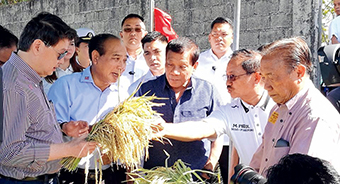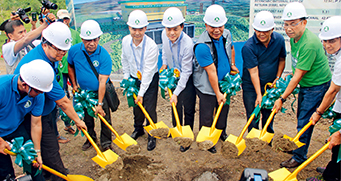In recent years, China and the Philippines have been engaging in cooperation on agriculture to promote the agricultural and economic development of both countries. William D. Dar, Minister of the Philippine Department of Agriculture, has commented that because the Philippines has a massive population of farmers and fishermen, the major driving force for its rural development should be effective technological strategies and modernization. “We know infrastructure is the centerpiece of the country’s ‘Build, Build, Build’ program, so why not launch a program to boost agriculture through related infrastructure?”
Irrigation
Situated on the north end of Luzon Island, the Chico River Pump Irrigation Project, a major China-Philippines joint venture, is underway.
The project straddles Kalinga and Cagayan, two major national crop production areas in northern Luzon. Jin Yuan, Business Counselor of the Chinese Embassy in the Philippines, called the Chico River Pump Irrigation Project an important result of cooperation between China and the Philippines. Its completion is expected to greatly increase the output of local crops and improve the lives of local people. The project also fits the aims of President Duterte’s “Build, Build, Build” program and could have a wide range of economic and social benefits.
On June 8, 2018, the groundbreaking ceremony of the Chico River Pump Irrigation Project was held in Kalinga Province, with construction estimated to last for three years. The pump station is supported by China’s preferential loans. According to Liu Shengcheng, deputy general manager of China CAMC Engineering Co., Ltd. (CAMCE), the company is contracted to build new irrigation systems and supporting facilities such as lifting pump stations, substations, supporting transmission lines, tunnels and channels on the right bank of the Chico River. The whole irrigation system will supply enough water to irrigate farmland as large as 8,700 hectares, which could directly benefit about 4,350 rural households in 22 villages.
In the Philippines, around 6.1 million hectares of farmland is served by irrigation structures, only 57 percent of the total. Ricardo R. Visaya, administrator of the National Irrigation Administration (NIA), is confident the project will boost economic and social development, increase agricultural productivity, and improve self-reliance on grain.
Chinese companies have completed multiple irrigation projects in the Philippines to upgrade local agricultural infrastructure. These projects include the Agno River Integrated Irrigation Project that provides irrigation services for 34,450 hectares farmland, the Banaoang Pump Irrigation Project with a designed irrigation area of 6,300 hectares, and the Casecnan Multipurpose Power Project in Nueva Ecija built for irrigation and flood control.
Hybrid Rice
Although rice is the most important crop in the Philippines, rice production in the country has remained relatively low for a long time. In 1979, Yuan Longping, a Chinese agronomist known for developing hybrid rice, visited the Philippines to participate in a global conference on crops. It was his first trip abroad, and he revisited the country many times thereafter. The Philippines became a launch pad for helping hybrid rice benefit the whole world.
In June 1999, the Chinese and Philippine governments signed a document on helping the Philippines develop hybrid rice. The same year, Zhang Zhaodong was appointed by Yuan Longping to bring the technology to the Philippines. Zhang began working with Chinese-Filipino businessman Lin Yuqing to develop, fund and promote hybrid rice in tropical areas.
During his two-decade stay in the Philippines, Zhang traversed the country to select hybrid rice species best-fit for local environments and promote planting of high-yield crop. In early 2001, Zhang and his colleagues finally found their holy grail: a tropical hybrid rice variety suitable for most environments in the Philippines. They called it Xiling 8.
Xiling 8 grabbed major attention the moment it was released. According to Lin, the highest per-unit yield of Xiling 8 testing reached 17 tons per hectare—particularly remarkable compared to the average three tons per hectare for local rice plants. Xiling 8 also demonstrated outstanding advantages in resistance and resilience to drought, flood, lodging as well as pests and diseases.
So far, nearly 100 Philippine farmers have realized yield of more than 15 tons per hectare by planting Xiling Series hybrid rice. Statistics from Philippine Department of Agriculture showed that in 2019, total planting area of Xiling Series hybrid rice reached 450,000 hectares, over a tenth of the farmland in the country.
The Chinese and Philippine governments have jointly established the Philippine-Sino Center for Agricultural Technology (PhilSCAT) and continue to carry out agricultural technology cooperation activities covering hybrid rice, agricultural machinery and biogas technology. Chinese agricultural experts and the agricultural technology they bring not only promote local agricultural development, but also sow seeds of friendship.
Fishery
In November 2016, Liu Xinzhong, deputy director of Bureau of Fisheries of Ministry of Agriculture of the People’s Republic of China, led a delegation to visit the Philippines. He recalled being astonished to find that in a place called Masinlok, local fishermen subsisted on primitive methods of fishing. “Their fishing boats were no wider than a meter, too small to resist winds and waves.” Liu suggested local fishermen visit China to learn better techniques, an idea the Philippine fishermen liked.
Two months later, a Philippine delegation of 17 people visited China for fishery training. Participants consisted of R&D professionals, workers, and executives in the fishery industry, mostly from coastal provinces such as Palawan, Zambales, and Davao. In the training classes, Chinese experts outlined content of specific interest to fishermen for the Philippine delegation including cage culture, seed rearing and nutritious feeding.
Willy Cruz, director of the third district of Ministry of Fisheries and Aquatic Resources and leader of the delegation, noted that the average monthly income of Philippine fishermen was only about 3,000 pesos (US$59), working in particularly dangerous conditions. Guo Genxi, researcher at the South China Sea Fisheries Research Institute, CAFS, responded that if the deep-sea cage culture could be widely adopted in the Philippines, the income of local fishermen could increase significantly while improving their safety exponentially.
Since 2017, China has offered nearly 100 Philippine fishery practitioners technical training on deep-water cage culture, pond farming, seedling rearing, marine algae and nutritious feeding. To support the Philippines’ development of aquaculture, the Chinese government has organized a yearly freshwater fish fry in the Philippine, which has been popular in the country of thousands of islands. Chinese fishery companies have invested in constructing numerous breeding bases in Davao City and other sea areas of the Philippines which have already created more than 300 jobs for local people.

On April 5, 2017, Philippine President Duterte listens to Lin Yuqing and Zhang Zhaodong on advantages of the “pioneer mix of tropical hybrid rice” at the “Harvest Day” in Rizal Province, where the Xiling Series hybrid rice was planted in 60 percent of paddy fields. President Duterte has been enthusiastic about planting tropical hybrid rice throughout the country.

Supported by loans from the Chinese government, the Chico River Pump Irrigation Project breaks ground in Kalinga Province of the Philippines on June 8, 2018.

The highest per-unit yield of Xiling 8 testing reached 17 tons per hectare—particularly remarkable compared to the average three tons per hectare for local rice plants.

In the Philippines, around 6.1 million hectares of farmland is served by irrigation structures, only 57 percent of the total.


 Copy Reference
Copy Reference